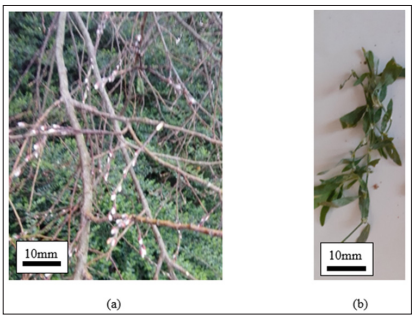Author(s): Solomon I Ubani
Selective catalytic reduction converted nitrogen oxides using a catalyst into diatomic nitrogen and water. A gaseous reductant typically ammonia
was added to the kinase from the host tree to the receptor of the plant. Before entering the catalyst chamber the ammonia and reductant were mixed
with the gas. A clay planting pot was used because of its porosity and high surface area. The results showed ethylene was an important aspect of plant growth and development of disulfide-linked receptor of the plant. This receptor featured a small transmembrane binding region and a large cytosolic region. It can be concluded the molecular weight complexes of different ethylene receptors and cellular participants of ethylene signaling pathway.
This research modelled a catalyst chamber where the nitrogen oxide takes place as the gas kinase transfers through it.
The experimental process consisted of a small angle data leading to a structural model of the entire cytosolic region of the ethylene receptor [1]. The design of the catalytic converter geometry was essential for the process. Signal converters were in bacterial receptors and kinases. The link the signal input modules in these proteins was ligand binding regions to output kinase regions [2]. In plants the transduce signals such as peptides perceived at receptors on the cell surface into the cytoplasm. To cascade a biochemical reaction. This enables the tree to transfer kinase for the plant growth and development, adaptation to UV in surroundings [3].
The experimental process consisted of a small angle leading to a structural model of the entire cytosolic region of the ethylene receptor 1. The model illustrated the cytosolic region was shaped like an ellipsoid and the receiver region was assumed a position different from the observed prokaryotic kinase. The model provided the step toward a detailed understanding of the transduction process in plants.
The existence of signaling was responsible for regulation of plant growth and development. The research showed the plant peptides was fundamentally similar to trees [4]. The binding modules were found in prokaryotes and eukaryotes. These were proteins in fungi known as transcriptional profiles
The kinase of trees and plants can be classified into fungal-specific and fungal-bacterial. In enzymes fungi binds with insoluble carbon sources. In plants, receptors contained symbiotic interactions between plants and bacteria or fungi. In plants, pathogenic fungi dampened the host tree immune response [5].
Small peptides mediate cell-cell kinase transfer to coordinate a variety of plant development processes. Signaling peptides specifically bind to extracellular regions of receptors. These were from receptor kinase classification. The peptide-receptor interaction activated a range of processes.
The plant root was important for stability in the soil as well as uptake of water and nutrients. There has been progress into the identification of receptors, structural research of peptide-receptors and characterization of their signaling pathways during plant root development [6].

Figure 1: Signal Response of (a) Host Tree Peptides and (b) Plant Receptors
Ethylene initiated important aspects of plant growth and development through disulfide-linked receptor. The receptors featured a small transmembrane, ethylene binding region on plant followed by a large cytosolic region on host tree. This was a platform for binding of large molecular weight complexes of different ethylene receptors and cellular participants of signaling pathway.
The report of ethylene receptor 1 catalytic ATP-binding and the ethylene response. The structures of the catalytic were homologous but dissimilar against experimental [7]. Transmembrane receptors were an important component of cellular signaling pathways. This determines the cell growth, differentiation of the trees and plants [8]. The protein contained extracellular region, a transmembrane region and intracellular kinase regions.
The improvement in the performance of the catalytic converter was attributed to the change in the kinase transfer distribution and kinase from the interior to the exterior chambers. The potential design improvements to achieve an optimum performance. In this study, both experimental and numerical research was carried out to understand the kinase transfer of the catalytic converter [9].
The development of the disulfide-linked receptor in the plant can be concluded that the molecular of ethylene signalling pathway is present. The link of the signal input in plants, the transduce signals such as peptides are perceived at cytoplasm to cascade a biochemical reaction. This enables the tree to transfer kinase for plant growth and development, as well as adaptation to UV in its surroundings. The plant’s roots are important for pathways during a plant’s root. The receptors feature a small transmembrane, ethylene binding region on the plant cytosolic region on the host tree. ATP-binding initiates an ethylene response dissimilar against experimental assessment the cell’s growth and the differentiation of the protein was contained in an extracellular. Comparative modelling of the kinase region as the plant peptides were fundamentally similar. These are proteins in fungi, which are known as enzymes, fungi binds with in plants, pathogenic fungi dampened.The properties were performed employing comparative modelling of kinase region as a template and phosphorylation assays of affinity purified proteins. Based on the computer modelling studies, activation loop of catalytic region of phosphorylation activity to illustrate the interaction of the protein with the downstream protein from host tree to receptor plant [8]. It was shown the kinase region interacts in the phosphorylation dependent process activation loop of the catalytic region produces phosphorylation activity [8]. In order to illustrate the the receiver region assumed a position. The model provided steps toward a detailed.
None
Conceptualization: Solomon I. Ubani
Methodology: Solomon I. Ubani
Investigation: Solomon I. Ubani
Visualization: Solomon I. Ubani
Supervision: Solomon I. Ubani
Writing—original draft: Solomon I. Ubani
Writing—review & editing: Solomon I. Ubani
Competing Interests: All other authors declare they have no competing interests.
Data and Materials Availability: “All data are available in the main text or the supplementary materials.”
